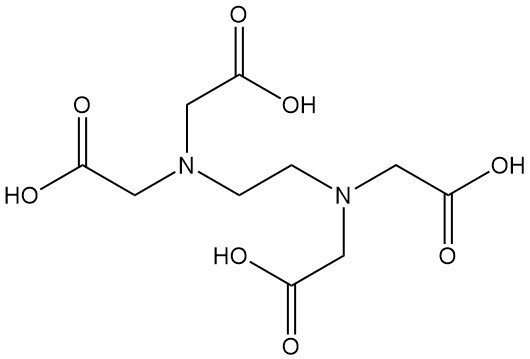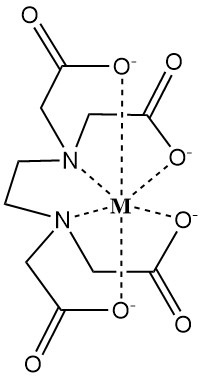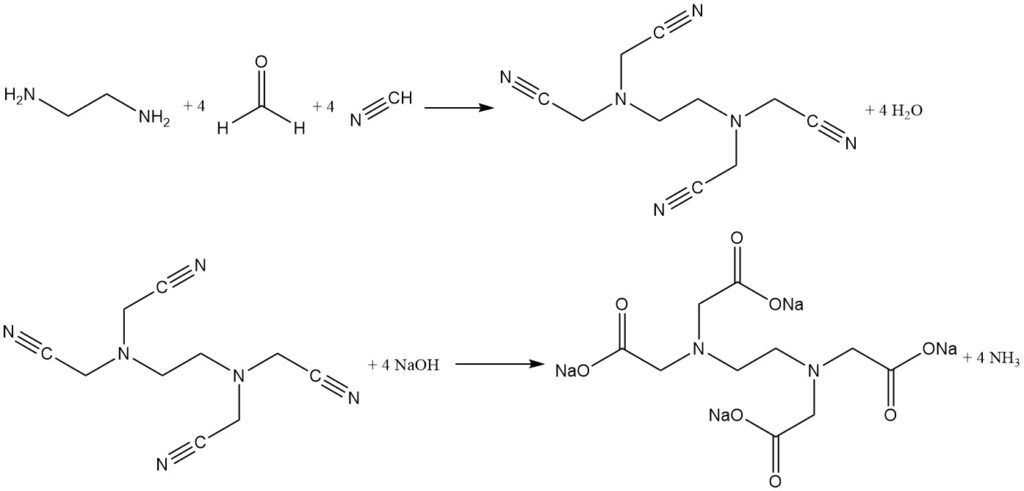Ethylenediaminetetraacetic Acid (EDTA): Properties, Production and Uses

What is Ethylenediaminetetraacetic Acid?
Ethylenediaminetetraacetic acid, better known as EDTA, is an aminopolycarboxylic acid with the formula C10H16N2O8. It is a white solid that is insoluble in water and is one of the most commonly used chelating agents in diverse industries.
Ethylenediaminetetraacetic acid (EDTA), nitrilotriacetic acid (NTA), and their respective salts were first synthesized in the 1930s by Ferdinand Munz from the I.G. Farbenindustrie laboratories. Since then, they have gained significant importance as industrial chelating agents.
Aminopolycarboxylic acids (such as EDTA), similar to amino acids, can form salts with strong acids and bases. Additionally, they possess the ability to form strong, water-soluble complexes with divalent and trivalent cations. These complexes significantly alter the reactivity of the metal ion, making them valuable compounds in various industrial processes.
The primary industrial application of EDTA is to prevent or remove scale and insoluble deposits containing calcium, barium, iron, and other cations.
Table of Contents
1. Physical Properties of Ethylenediaminetetraacetic Acid (EDTA)
Ethylenediaminetetraacetic acid is a colorless, crystalline solid that is slightly soluble in water. Important physical properties of EDTA are listed in the following table.
| Property | Value |
|---|---|
| CAS number | [60-00-4] |
| Chemical formula | C10H16N2O8 |
| Molecular weight | 292.24 g/mol |
| Melting point | 245 °C (decomposition) |
| Relative density | 0.86 g/cm3 |
| Solubility in water at 20 °C | 0.1 g/L |
| pKa1 | 2 |
| pKa2 | 2.7 |
| pKa3 | 6.16 |
| pKa4 | 10.26 |
| Flash point | > 100 °C |
2. Chemical Properties of Ethylenediaminetetraacetic Acid
EDTA forms water-soluble complexes with divalent and trivalent metal cations. These complexes feature a ring structure called a chelate (from the Greek “chele,” meaning claw), where the metal ion is tightly bound by the dissociated ligand EDTA4-.
The strength of this complex is quantified by the stability constant, which reflects the equilibrium concentrations of the metal ion (M) and chelating agent (EDTA4-).

Factors affecting the chelation strength are pH, competing anions, and precipitating anions.
Higher pH favors chelation as it increases the concentration of fully dissociated chelate anions (e.g., EDTA4-), enhancing their binding capacity. However, this effect can be counteracted by hydroxyl ions (OH–) at high pH, which can disrupt metal chelates if the metal forms insoluble hydroxides (e.g., Fe3+ precipitation above pH 5.5).
Anions like carbonate, phosphate, and oxalate can compete with the chelating agent, reducing the effective strength of the metal-chelating agent complex.
Generally, chelating agents like EDTA form 1:1 complexes with metal ions. However, increasing the chelating agent concentration beyond 1:1 can further enhance stability.
Converting metal cations to anionic metal complexes alters their interaction with other species. For example, the negatively charged [Fe(III)(EDTA)]– complex can move more readily through soil compared to the absorbed Fe3+ cation.
Chelation lowers the concentration of free metal ions (M) by complex formation, effectively increasing the effective oxidation potential. This principle is the basis for various important industrial processes.
3. Production of Ethylenediaminetetraacetic Acid (EDTA)
Ethylenediaminetetraacetic acid (EDTA) was commercially produced by the reaction of ethylenediamine, chloroacetic acid, and sodium hydroxide. This process resulted in a product contaminated with sodium chloride and has been abandoned due to purification challenges.
Other methods, like the catalytic oxidation of specific starting materials, were explored but never commercially adopted.
Today, two main processes dominate EDTA and related chelating agent production, both involving the cyanomethylation of the parent polyamine.
3.1. The alkaline cyanomethylation of ethylenediamine
The alkaline cyanomethylation of ethylenediamine is the most widely used process for synthesizing ethylenediamine tetraacetic acid.

Sodium cyanide and formaldehyde react with ethylenediamine to produce EDTA at high yields (over 90%). Ammonia is the primary byproduct and is continuously removed during the reaction. However, minor amounts of ammonia react to form salts of unwanted byproducts like nitrilotriacetic acid and glycine.
Glycolic acid salts can also be formed from the reaction between starting materials. These impurities have minimal impact on most chelating agent applications.
3.2. The two-step Singer synthesis
The two-step Singer synthesis separates the cyanomethylation step from the hydrolysis reaction. Here, hydrogen cyanide and formaldehyde react with ethylenediamine to form a high-yield (over 96%) intermediate product, (ethylenedinitrilo)tetraacetonitrile.
This insoluble intermediate is isolated, washed, and then hydrolyzed with sodium hydroxide to yield pure tetrasodium EDTA with ammonia as a byproduct. Separating the reaction into two steps minimizes impurity formation and produces a highly purified chelating agent.

This two-step approach is also used for efficient production of pure nitrilotriacetic acid using ammonia.
4. Uses of Ethylenediaminetetraacetic Acid (EDTA)
Chelating agents like EDTA, with their unique ability to bind and inactivate metal ions, find applications across various industries.
EDTA-type chelating agents prevent unwanted color changes in dyes by complexing trace metal contaminants from fibers, chemicals, and water.
EDTA improves the brightness of paper pulp bleached with hydrogen peroxide or dithionite. It acts as a stabilizer and metal ion control agent during the pulping and bleaching stages.
EDTA is used to clean scale deposits from boilers and prevent the formation of calcium and magnesium scales by complexing these metal ions. However, proper dosage control is important to avoid excessive chelating agents leading to corrosion.
Polymers are sometimes used in conjunction with chelating agents to minimize their corrosive potential.
EDTA can be employed to help clean metal surfaces by dissolving adherent oxide films, allowing for thorough rinsing. Metal plating solutions often add chelating agents like EDTA to form complex metal ions, resulting in smoother and more uniform metal coatings.
Laundry detergents, hard surface cleaners, and bathroom cleansers add EDTA, which enhances their cleaning power.
EDTA disrupts the outer cell wall of certain bacteria, particularly gram-negative bacteria, increasing the effectiveness of sanitizing agents. It also acts as a preservative booster in cosmetics, shampoos, and ophthalmic products by increasing their bactericidal activity.
Ethylenediaminetetraacetic acid prevents oxidative rancidity in fatty emulsions like mayonnaise and salad dressings by complexing metal ions that can accelerate spoilage. Also, it prevents discoloration caused by iron in foods like potatoes.
Chelation with EDTA is used commercially in the emulsion polymerization of styrene-butadiene rubber and the bleaching of photographic film. Iron chelates are employed to control industrial emissions of hydrogen sulfide and as reversible absorbents for nitrogen oxides.
Trace metal ions can interfere with chemical processes. Chelating agents like EDTA remove these unwanted metals to ensure process efficiency and meet product specifications.
Micronutrients like iron, zinc, manganese, and copper are added to fertilizers in chelated forms. This prevents them from interacting with phosphates and other soil components that can cause precipitation and reduce their uptake by plants.
The chelation allows these micronutrients to move more readily through the soil to the root zone for plant absorption.
EDTA is widely used in titrimetric methods due to the rapid change in free metal ion concentration at the equivalence point. It is also used as a masking agent in some spectrophotometric methods to eliminate interference from metal ions.
EDTA is the dominant chelating agent, accounting for nearly half of the total consumption in Western Europe (78,000 metric tons in 2004). Major producers include Dow Chemical, BASF, and AkZO.
5. Toxicology of EDTA
EDTA and its salts have a long history of safe use in various applications, including food additives, pharmaceuticals, and cosmetics. Early toxicological studies suggest relatively low toxicity.
Studies on rats indicate a high lethal dose (LD50) for Na2EDTA (disodium salt), ranging from 2.0 to 2.2 grams per kilogram of body weight.
Studies using Na2EDTA at 0.5% to 5.0% in the diet showed no significant adverse effects except for diarrhea and reduced food intake at the highest dosage. Trisodium EDTA does not appear to be a skin sensitizer.
While EDTA can interact with genetic material, its relevance to human genotoxicity (causing genetic damage) seems minimal. Studies on Na3EDTA (trisodium salt) haven’t shown any carcinogenicity related to the compound.
Reference
- Ethylenediaminetetraacetic Acid and Related Chelating Agents; Ullmann’s Encyclopedia of Industrial Chemistry. – https://onlinelibrary.wiley.com/doi/10.1002/14356007.a10_095.pub2
